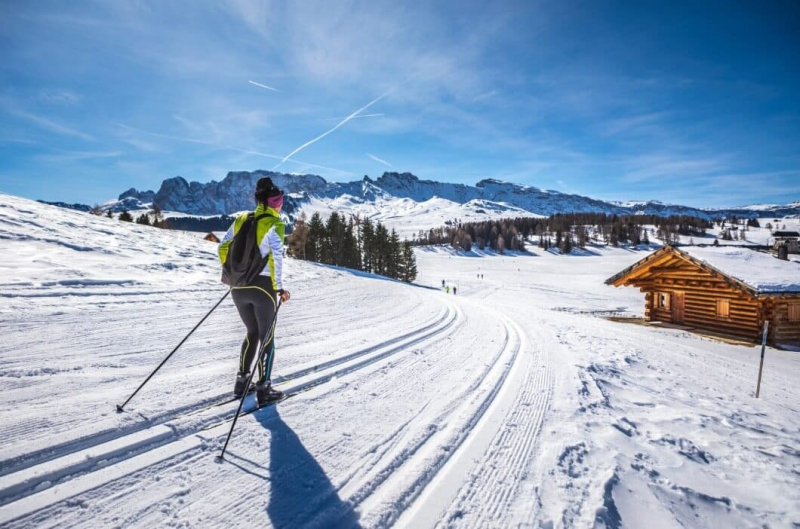Italy’s winter wonderlands, from the Dolomites’ sharp peaks to the Apennines’ frosty paths, are gearing up for another go on the winter tourism ride. Picture this: fresh tracks carved on skis, snowshoeing under the moon, or simply enjoying that post-ski buzz. Mountain resorts are anticipating a season of, let’s say, steady growth –nothing too wild, though. Forecasts suggest visitor numbers will nudge up 3.8 percent for 2025/2026, fueled mostly by international snow fans, even as local visitors dwindle and day-trippers opt out.
The Italian Mountain Tourism Observatory calls it “positive, yet not ecstatic.” This measured optimism, amid economic hurdles and climate worries, highlights the sector’s adaptability – a balance between global charm and local practicalities.
International Powder Hounds Offset Domestic Decline
The brightest spot this season? It’s definitely the international scene. Foreign arrivals should rise by 8 to 8.8 percent, which more than makes up for the 3.9 percent drop in Italian visitors and the pretty significant 14.5 percent fall in same-day trips. Foreign guests are the power source here, opting for longer stays that bring stability. At an average of 6.2 nights per trip, they are really boosting the high-altitude economies.
Key markets are leading the charge: Poland is up a solid 29.6 percent, with the UK following at 15.9 percent, and the Czech Republic at 8.2 percent. These groups, often families or adventure seekers, are drawn to Italy’s renowned slopes for everything from intense ski touring to peaceful cross-country hikes. Meanwhile, Italians are shifting towards “different” experiences – perhaps snowshoeing in the off-season or quick midweek escapes – with 38.9 percent already booking ahead, a smart move against rising prices and unpredictable weather.
This indicates a market in transition: domestic travelers, feeling the pinch of inflation, are prioritizing value over volume, while international visitors are after Italy’s unique combination of elegance and ruggedness.
Italy’s Winter Tourism Revenue Peaks at €12 Billion
The numbers, while good, aren’t amazing. Total sector revenue should hit €12.101 billion, a 3.6 percent increase from last winter. Hotels are still king, bringing in €5.9 billion with their cozy chalets and spa options, the heart of mountain hospitality. Next: sports and facility services at €4.78 billion, including lift tickets, rentals, and tours that keep the adrenaline flowing. Rounding out the list, food, retail, and entertainment ring in at €1.42 billion – think delicious fondues, après-ski drinks, and slope-side shopping.
This supports the sector’s resilience, balancing quality and sustainability. It underscores that Italy’s mountains are more than just fun zones; they are eco-aware places where innovation (like solar-powered lifts and zero-waste kitchens) blends with timeless appeal.
A 5.8% Price Hike Hits Holiday Wallets
But good times come at a cost. Expect to pay roughly 5.8 percent more for your winter fun this year, with hotels feeling it most: ski weeks are up 6.3 percent, and weekends/peak periods are up 9.7 percent. Ski schools follow at +4.9 percent, ski passes at +4.1 percent, and bar/restaurant bills at +5.5 percent.
Click here to preview your posts with PRO themes ››
Let’s do the math: A full week of skiing for one adult averages €1,545, while a family of three pays out €4,017 – a 6.3 percent increase. Weekends are pricier: €622 per adult, €1,773 for a family, up 8.8 percent. Looking back three years, price increases reveal a split: weekend/peak hotel stays have jumped 30.3 percent, outpacing bars/restaurants at 26.6 percent, ski schools at 19.6 percent, and ski lifts/ski-week hotels at around 17.5-17.6 percent. Hotels are diverging from the general slowdown, as operators try to recover from post-pandemic setbacks through higher pricing.

Sustainability and Innovation to 2030
The unfolding decade, envisioned as a “time of transition” culminating around 2030, casts destinations into a spotlight. Their long-term prospects rely significantly on how well they can interweave elements of quality, sustainable practices, and innovative thinking. Weather anomalies – compressed winter seasons, inconsistent snowfall patterns – necessitate flexible strategies: imagine snowmaking technologies, efforts to bolster biodiversity, and carbon-neutral transportation options. Competitiveness in this era isn’t only about having the most challenging ski slopes; rather, it’s about cultivating lasting attraction.
The Italian trend of booking trips during less busy times gives insight into this shift, emphasizing immersive moments instead of mere luxury. As tourists globally are increasingly conscious of reducing environmental impacts, the Italian Alps might well chart a course, demonstrating a model that is both luxurious and ecologically mindful, exciting yet also reflective.
Crown Jewels of the Italian Slopes
Cortina d’Ampezzo secures its position as “Ski Destination of the Year” in the latest Observatory rankings, blending prestige, high style, and a certain allure that solidifies its appeal among well-heeled travelers, especially looking forward to the 2026 Winter Olympics. Following closely is Madonna di Campiglio, recognized for excellent ski runs, a welcoming atmosphere for families, and a plethora of amenities. Livigno, the duty-free haven, garners the bronze, noted for its ecological focus and practices.
Additional distinctions exist: Moena is named “most accessible,” offering simple access, and Courmayeur stands out because of its exceptional lodging choices. These highlighted locales represent not just points on a geographical map; they signify achievements in a domain that is striving to remain relevant and exciting.
As ski lifts begin operation and freshly fallen snow blankets the Dolomite mountains, Italy’s winter scene emerges with guarded optimism. While growth might be moderate and prices might rise somewhat sharply, the charm remains. Snow-covered towns narrate stories filled with adventure, and each slope offers not simply a thrilling descent, but also a feeling of peace. For those devoted to the Alps and Apennines, this experience is sufficiently fulfilling.


